Investigating Work-Life Balance and Employee Productivity in Business
VerifiedAdded on 2023/06/18
|6
|1472
|71
Report
AI Summary
This report investigates the impact of work-life balance on employee productivity, analyzing the relationship between work-life balance practices and organizational efficiency. It examines whether work-life balance practices can reduce worker turnover and absenteeism, and explores the challenges employees face in achieving work-life balance. Various work-life balance options, such as job-sharing, flexible leave policies, and childcare support, are discussed, along with the challenges in implementing these policies. Recommendations include increased usage of flexible work options, revaluation of existing policies, equitable implementation of work-life balance rules, social events to reduce workplace stress, and dedicated counseling sessions. The report concludes that improving work-life balance benefits both companies and workers, leading to increased productivity, satisfaction, and organizational engagement.
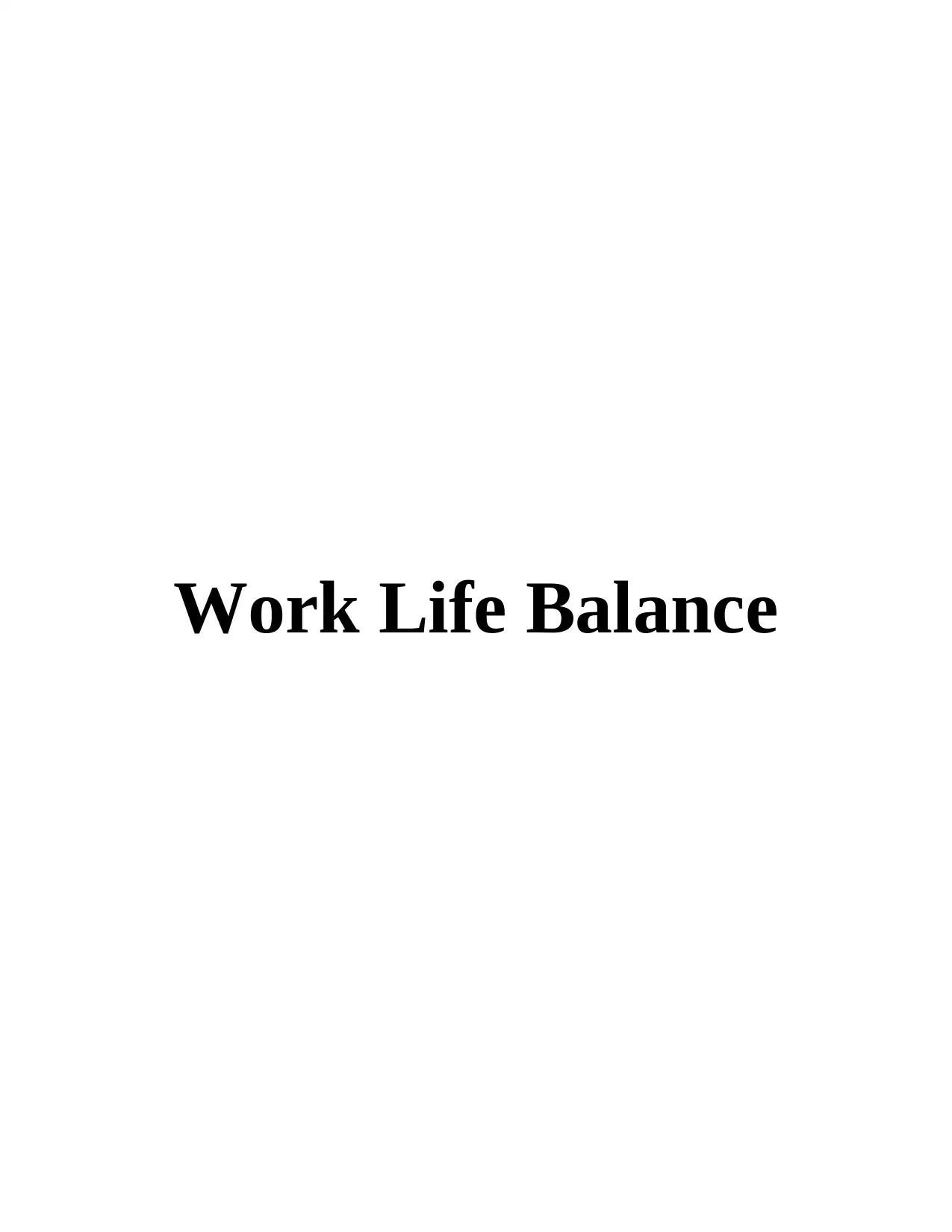
Work Life Balance
Paraphrase This Document
Need a fresh take? Get an instant paraphrase of this document with our AI Paraphraser
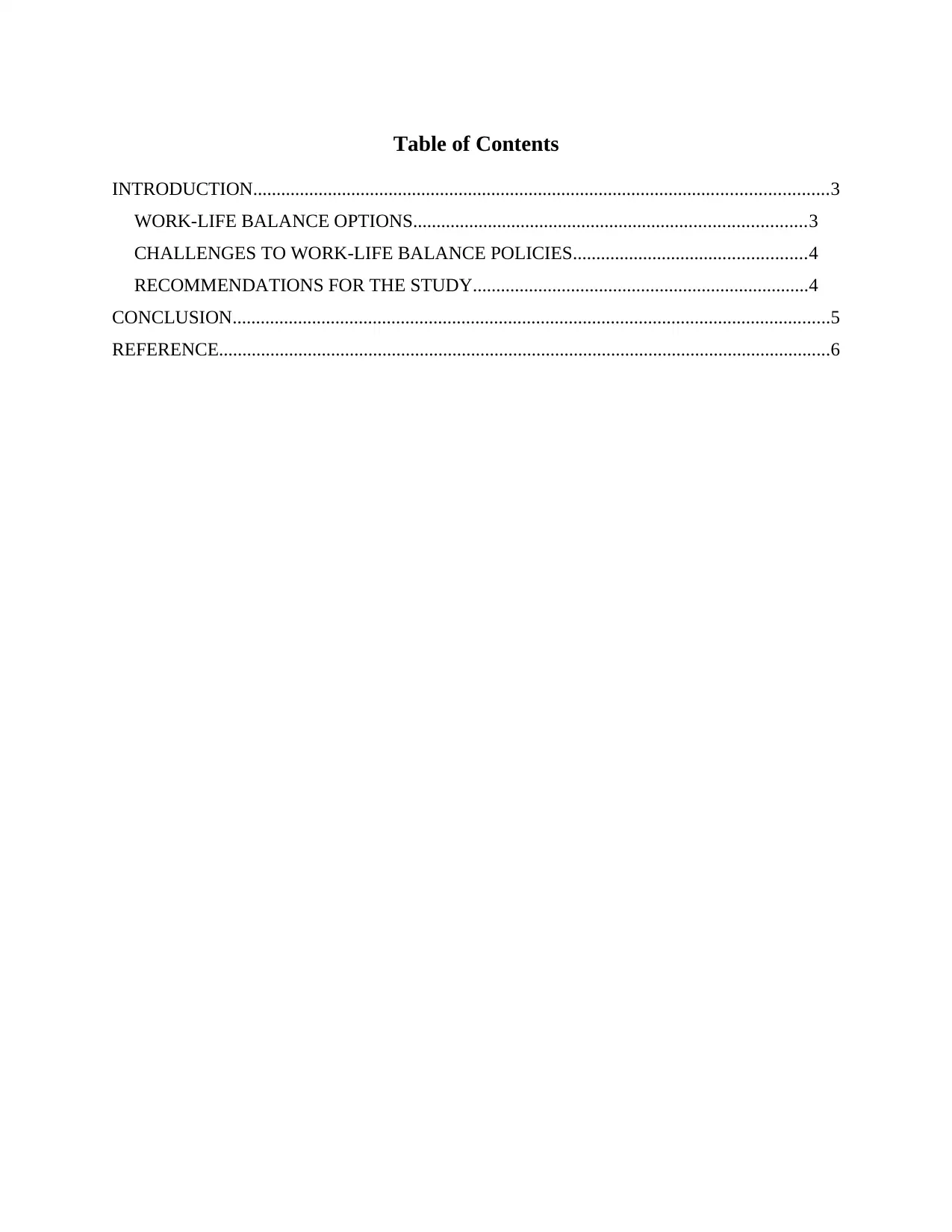
Table of Contents
INTRODUCTION...........................................................................................................................3
WORK-LIFE BALANCE OPTIONS....................................................................................3
CHALLENGES TO WORK-LIFE BALANCE POLICIES..................................................4
RECOMMENDATIONS FOR THE STUDY........................................................................4
CONCLUSION................................................................................................................................5
REFERENCE...................................................................................................................................6
INTRODUCTION...........................................................................................................................3
WORK-LIFE BALANCE OPTIONS....................................................................................3
CHALLENGES TO WORK-LIFE BALANCE POLICIES..................................................4
RECOMMENDATIONS FOR THE STUDY........................................................................4
CONCLUSION................................................................................................................................5
REFERENCE...................................................................................................................................6
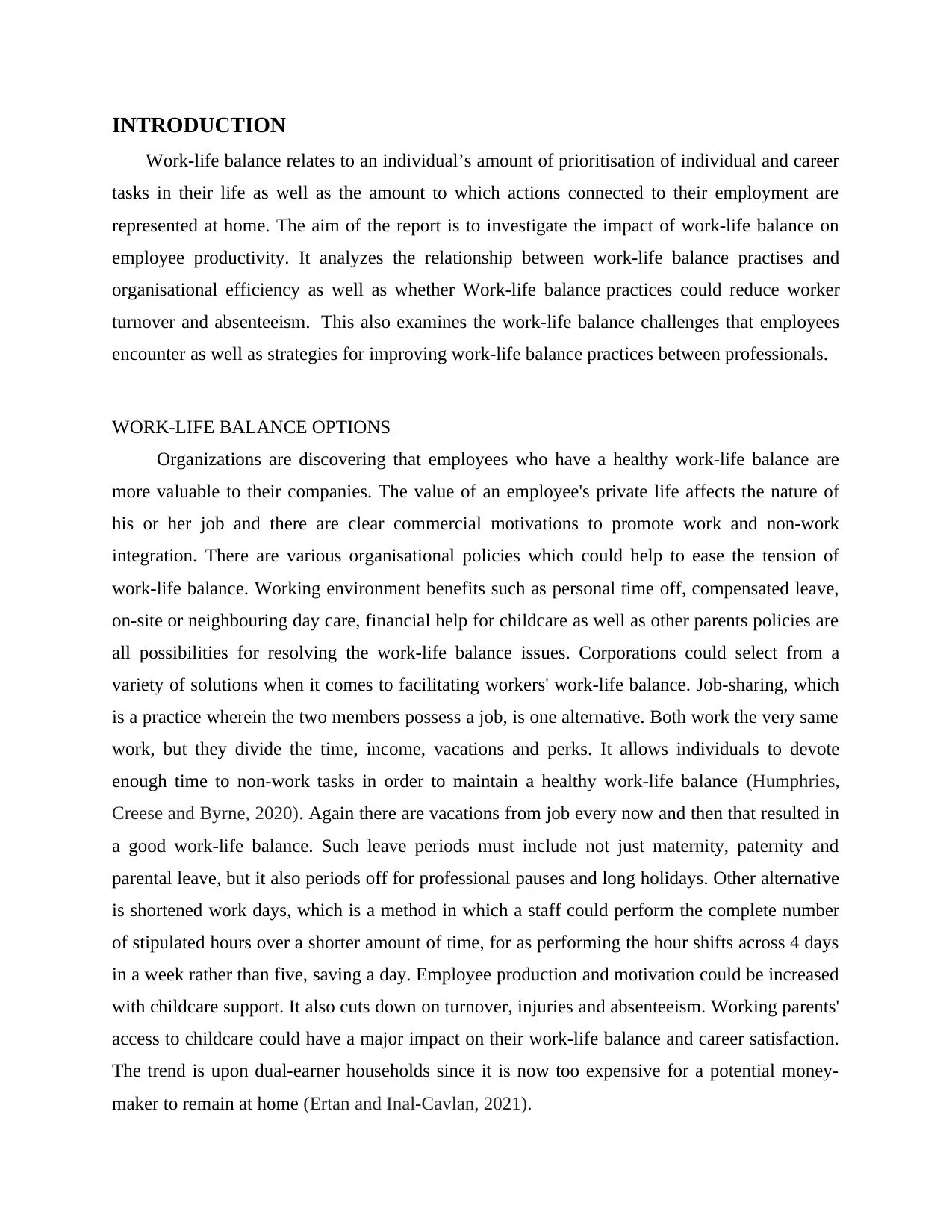
INTRODUCTION
Work-life balance relates to an individual’s amount of prioritisation of individual and career
tasks in their life as well as the amount to which actions connected to their employment are
represented at home. The aim of the report is to investigate the impact of work-life balance on
employee productivity. It analyzes the relationship between work-life balance practises and
organisational efficiency as well as whether Work-life balance practices could reduce worker
turnover and absenteeism. This also examines the work-life balance challenges that employees
encounter as well as strategies for improving work-life balance practices between professionals.
WORK-LIFE BALANCE OPTIONS
Organizations are discovering that employees who have a healthy work-life balance are
more valuable to their companies. The value of an employee's private life affects the nature of
his or her job and there are clear commercial motivations to promote work and non-work
integration. There are various organisational policies which could help to ease the tension of
work-life balance. Working environment benefits such as personal time off, compensated leave,
on-site or neighbouring day care, financial help for childcare as well as other parents policies are
all possibilities for resolving the work-life balance issues. Corporations could select from a
variety of solutions when it comes to facilitating workers' work-life balance. Job-sharing, which
is a practice wherein the two members possess a job, is one alternative. Both work the very same
work, but they divide the time, income, vacations and perks. It allows individuals to devote
enough time to non-work tasks in order to maintain a healthy work-life balance (Humphries,
Creese and Byrne, 2020). Again there are vacations from job every now and then that resulted in
a good work-life balance. Such leave periods must include not just maternity, paternity and
parental leave, but it also periods off for professional pauses and long holidays. Other alternative
is shortened work days, which is a method in which a staff could perform the complete number
of stipulated hours over a shorter amount of time, for as performing the hour shifts across 4 days
in a week rather than five, saving a day. Employee production and motivation could be increased
with childcare support. It also cuts down on turnover, injuries and absenteeism. Working parents'
access to childcare could have a major impact on their work-life balance and career satisfaction.
The trend is upon dual-earner households since it is now too expensive for a potential money-
maker to remain at home (Ertan and Inal-Cavlan, 2021).
Work-life balance relates to an individual’s amount of prioritisation of individual and career
tasks in their life as well as the amount to which actions connected to their employment are
represented at home. The aim of the report is to investigate the impact of work-life balance on
employee productivity. It analyzes the relationship between work-life balance practises and
organisational efficiency as well as whether Work-life balance practices could reduce worker
turnover and absenteeism. This also examines the work-life balance challenges that employees
encounter as well as strategies for improving work-life balance practices between professionals.
WORK-LIFE BALANCE OPTIONS
Organizations are discovering that employees who have a healthy work-life balance are
more valuable to their companies. The value of an employee's private life affects the nature of
his or her job and there are clear commercial motivations to promote work and non-work
integration. There are various organisational policies which could help to ease the tension of
work-life balance. Working environment benefits such as personal time off, compensated leave,
on-site or neighbouring day care, financial help for childcare as well as other parents policies are
all possibilities for resolving the work-life balance issues. Corporations could select from a
variety of solutions when it comes to facilitating workers' work-life balance. Job-sharing, which
is a practice wherein the two members possess a job, is one alternative. Both work the very same
work, but they divide the time, income, vacations and perks. It allows individuals to devote
enough time to non-work tasks in order to maintain a healthy work-life balance (Humphries,
Creese and Byrne, 2020). Again there are vacations from job every now and then that resulted in
a good work-life balance. Such leave periods must include not just maternity, paternity and
parental leave, but it also periods off for professional pauses and long holidays. Other alternative
is shortened work days, which is a method in which a staff could perform the complete number
of stipulated hours over a shorter amount of time, for as performing the hour shifts across 4 days
in a week rather than five, saving a day. Employee production and motivation could be increased
with childcare support. It also cuts down on turnover, injuries and absenteeism. Working parents'
access to childcare could have a major impact on their work-life balance and career satisfaction.
The trend is upon dual-earner households since it is now too expensive for a potential money-
maker to remain at home (Ertan and Inal-Cavlan, 2021).
⊘ This is a preview!⊘
Do you want full access?
Subscribe today to unlock all pages.

Trusted by 1+ million students worldwide
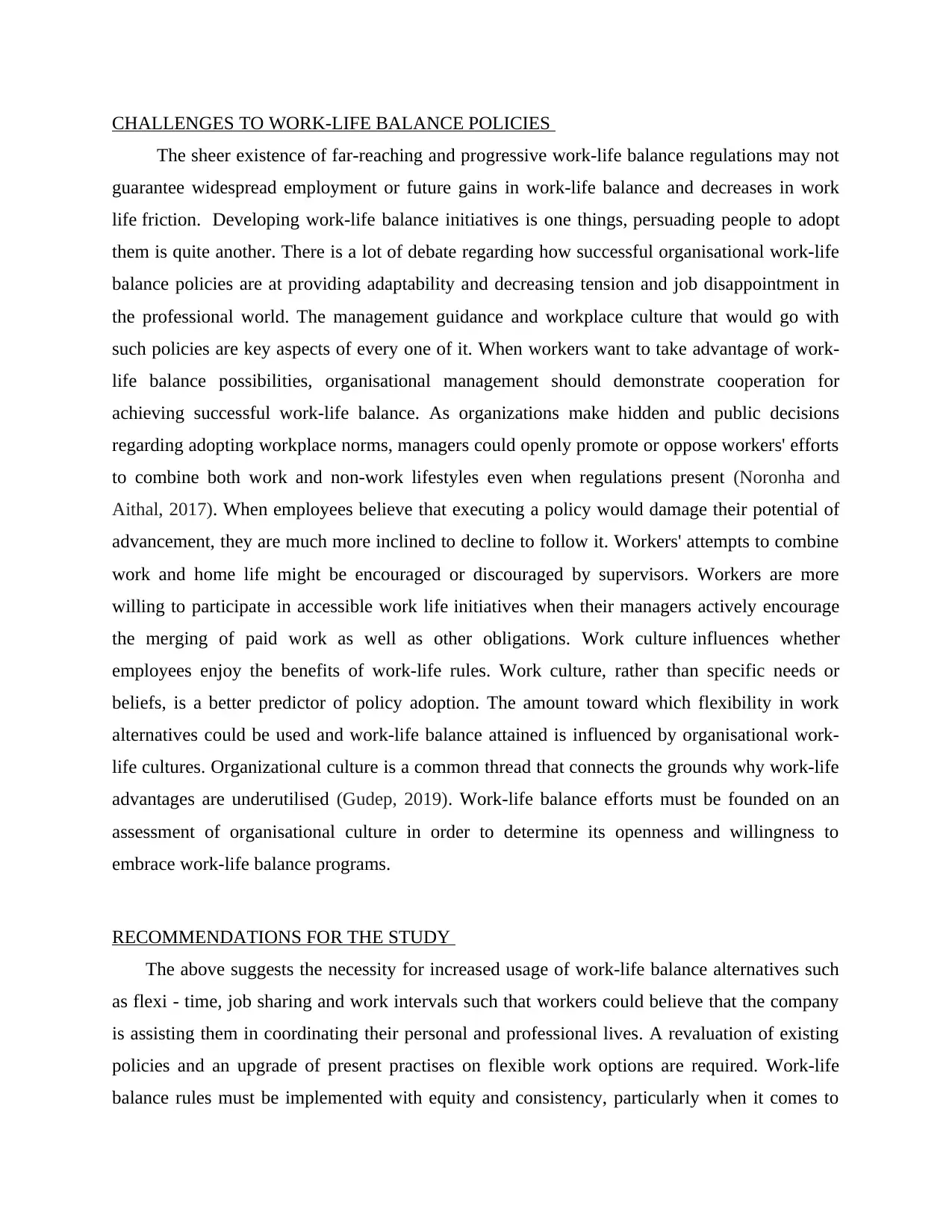
CHALLENGES TO WORK-LIFE BALANCE POLICIES
The sheer existence of far-reaching and progressive work-life balance regulations may not
guarantee widespread employment or future gains in work-life balance and decreases in work
life friction. Developing work-life balance initiatives is one things, persuading people to adopt
them is quite another. There is a lot of debate regarding how successful organisational work-life
balance policies are at providing adaptability and decreasing tension and job disappointment in
the professional world. The management guidance and workplace culture that would go with
such policies are key aspects of every one of it. When workers want to take advantage of work-
life balance possibilities, organisational management should demonstrate cooperation for
achieving successful work-life balance. As organizations make hidden and public decisions
regarding adopting workplace norms, managers could openly promote or oppose workers' efforts
to combine both work and non-work lifestyles even when regulations present (Noronha and
Aithal, 2017). When employees believe that executing a policy would damage their potential of
advancement, they are much more inclined to decline to follow it. Workers' attempts to combine
work and home life might be encouraged or discouraged by supervisors. Workers are more
willing to participate in accessible work life initiatives when their managers actively encourage
the merging of paid work as well as other obligations. Work culture influences whether
employees enjoy the benefits of work-life rules. Work culture, rather than specific needs or
beliefs, is a better predictor of policy adoption. The amount toward which flexibility in work
alternatives could be used and work-life balance attained is influenced by organisational work-
life cultures. Organizational culture is a common thread that connects the grounds why work-life
advantages are underutilised (Gudep, 2019). Work-life balance efforts must be founded on an
assessment of organisational culture in order to determine its openness and willingness to
embrace work-life balance programs.
RECOMMENDATIONS FOR THE STUDY
The above suggests the necessity for increased usage of work-life balance alternatives such
as flexi - time, job sharing and work intervals such that workers could believe that the company
is assisting them in coordinating their personal and professional lives. A revaluation of existing
policies and an upgrade of present practises on flexible work options are required. Work-life
balance rules must be implemented with equity and consistency, particularly when it comes to
The sheer existence of far-reaching and progressive work-life balance regulations may not
guarantee widespread employment or future gains in work-life balance and decreases in work
life friction. Developing work-life balance initiatives is one things, persuading people to adopt
them is quite another. There is a lot of debate regarding how successful organisational work-life
balance policies are at providing adaptability and decreasing tension and job disappointment in
the professional world. The management guidance and workplace culture that would go with
such policies are key aspects of every one of it. When workers want to take advantage of work-
life balance possibilities, organisational management should demonstrate cooperation for
achieving successful work-life balance. As organizations make hidden and public decisions
regarding adopting workplace norms, managers could openly promote or oppose workers' efforts
to combine both work and non-work lifestyles even when regulations present (Noronha and
Aithal, 2017). When employees believe that executing a policy would damage their potential of
advancement, they are much more inclined to decline to follow it. Workers' attempts to combine
work and home life might be encouraged or discouraged by supervisors. Workers are more
willing to participate in accessible work life initiatives when their managers actively encourage
the merging of paid work as well as other obligations. Work culture influences whether
employees enjoy the benefits of work-life rules. Work culture, rather than specific needs or
beliefs, is a better predictor of policy adoption. The amount toward which flexibility in work
alternatives could be used and work-life balance attained is influenced by organisational work-
life cultures. Organizational culture is a common thread that connects the grounds why work-life
advantages are underutilised (Gudep, 2019). Work-life balance efforts must be founded on an
assessment of organisational culture in order to determine its openness and willingness to
embrace work-life balance programs.
RECOMMENDATIONS FOR THE STUDY
The above suggests the necessity for increased usage of work-life balance alternatives such
as flexi - time, job sharing and work intervals such that workers could believe that the company
is assisting them in coordinating their personal and professional lives. A revaluation of existing
policies and an upgrade of present practises on flexible work options are required. Work-life
balance rules must be implemented with equity and consistency, particularly when it comes to
Paraphrase This Document
Need a fresh take? Get an instant paraphrase of this document with our AI Paraphraser
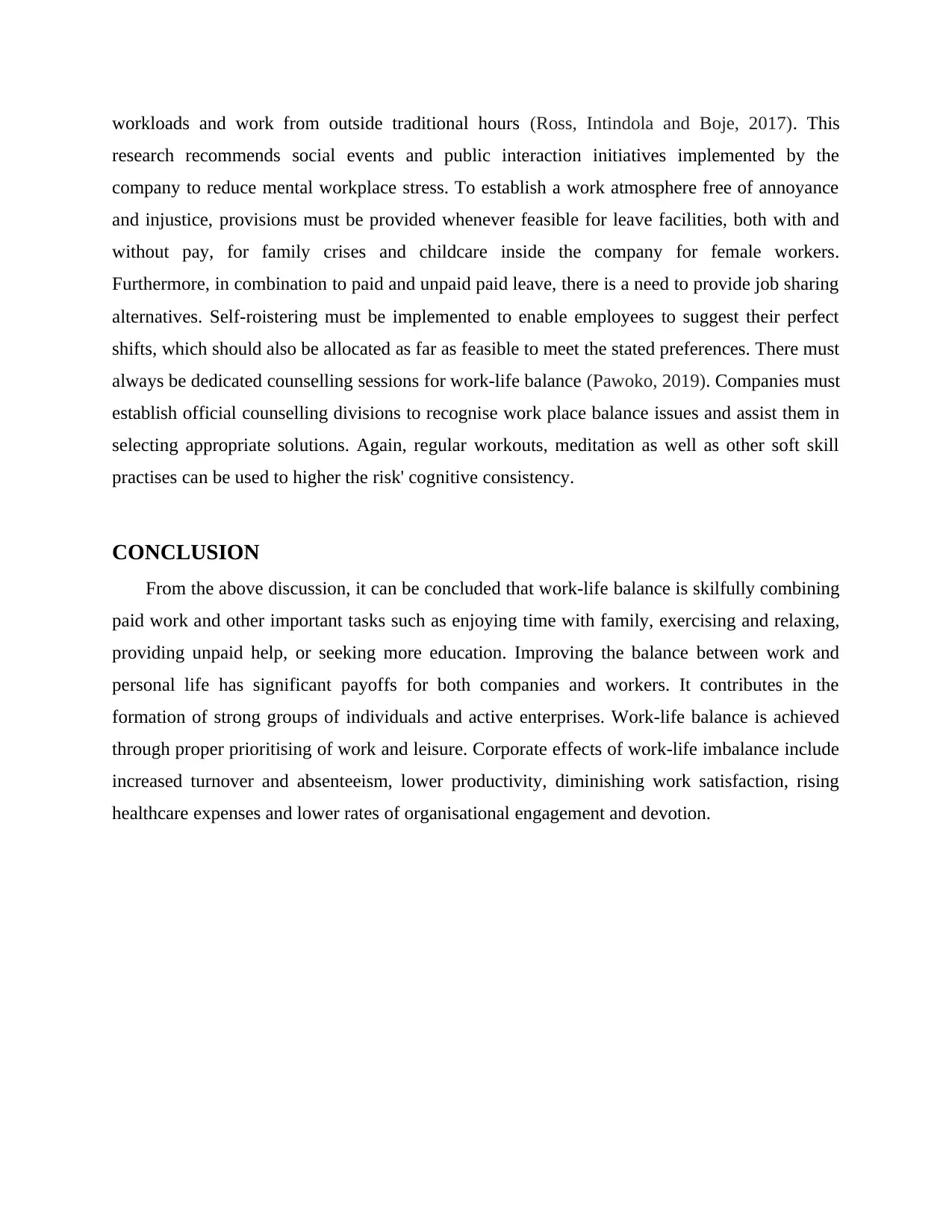
workloads and work from outside traditional hours (Ross, Intindola and Boje, 2017). This
research recommends social events and public interaction initiatives implemented by the
company to reduce mental workplace stress. To establish a work atmosphere free of annoyance
and injustice, provisions must be provided whenever feasible for leave facilities, both with and
without pay, for family crises and childcare inside the company for female workers.
Furthermore, in combination to paid and unpaid paid leave, there is a need to provide job sharing
alternatives. Self-roistering must be implemented to enable employees to suggest their perfect
shifts, which should also be allocated as far as feasible to meet the stated preferences. There must
always be dedicated counselling sessions for work-life balance (Pawoko, 2019). Companies must
establish official counselling divisions to recognise work place balance issues and assist them in
selecting appropriate solutions. Again, regular workouts, meditation as well as other soft skill
practises can be used to higher the risk' cognitive consistency.
CONCLUSION
From the above discussion, it can be concluded that work-life balance is skilfully combining
paid work and other important tasks such as enjoying time with family, exercising and relaxing,
providing unpaid help, or seeking more education. Improving the balance between work and
personal life has significant payoffs for both companies and workers. It contributes in the
formation of strong groups of individuals and active enterprises. Work-life balance is achieved
through proper prioritising of work and leisure. Corporate effects of work-life imbalance include
increased turnover and absenteeism, lower productivity, diminishing work satisfaction, rising
healthcare expenses and lower rates of organisational engagement and devotion.
research recommends social events and public interaction initiatives implemented by the
company to reduce mental workplace stress. To establish a work atmosphere free of annoyance
and injustice, provisions must be provided whenever feasible for leave facilities, both with and
without pay, for family crises and childcare inside the company for female workers.
Furthermore, in combination to paid and unpaid paid leave, there is a need to provide job sharing
alternatives. Self-roistering must be implemented to enable employees to suggest their perfect
shifts, which should also be allocated as far as feasible to meet the stated preferences. There must
always be dedicated counselling sessions for work-life balance (Pawoko, 2019). Companies must
establish official counselling divisions to recognise work place balance issues and assist them in
selecting appropriate solutions. Again, regular workouts, meditation as well as other soft skill
practises can be used to higher the risk' cognitive consistency.
CONCLUSION
From the above discussion, it can be concluded that work-life balance is skilfully combining
paid work and other important tasks such as enjoying time with family, exercising and relaxing,
providing unpaid help, or seeking more education. Improving the balance between work and
personal life has significant payoffs for both companies and workers. It contributes in the
formation of strong groups of individuals and active enterprises. Work-life balance is achieved
through proper prioritising of work and leisure. Corporate effects of work-life imbalance include
increased turnover and absenteeism, lower productivity, diminishing work satisfaction, rising
healthcare expenses and lower rates of organisational engagement and devotion.
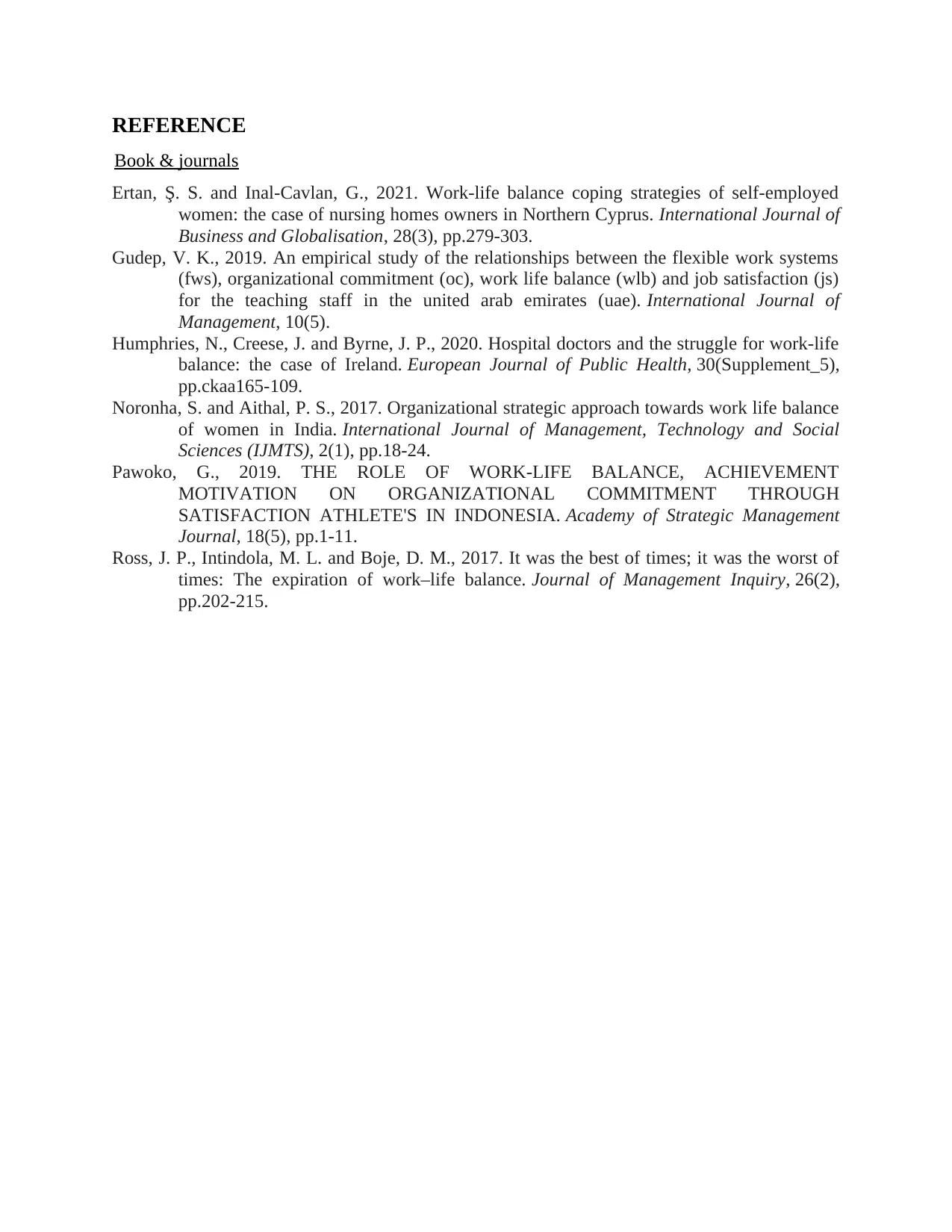
REFERENCE
Book & journals
Ertan, Ş. S. and Inal-Cavlan, G., 2021. Work-life balance coping strategies of self-employed
women: the case of nursing homes owners in Northern Cyprus. International Journal of
Business and Globalisation, 28(3), pp.279-303.
Gudep, V. K., 2019. An empirical study of the relationships between the flexible work systems
(fws), organizational commitment (oc), work life balance (wlb) and job satisfaction (js)
for the teaching staff in the united arab emirates (uae). International Journal of
Management, 10(5).
Humphries, N., Creese, J. and Byrne, J. P., 2020. Hospital doctors and the struggle for work-life
balance: the case of Ireland. European Journal of Public Health, 30(Supplement_5),
pp.ckaa165-109.
Noronha, S. and Aithal, P. S., 2017. Organizational strategic approach towards work life balance
of women in India. International Journal of Management, Technology and Social
Sciences (IJMTS), 2(1), pp.18-24.
Pawoko, G., 2019. THE ROLE OF WORK-LIFE BALANCE, ACHIEVEMENT
MOTIVATION ON ORGANIZATIONAL COMMITMENT THROUGH
SATISFACTION ATHLETE'S IN INDONESIA. Academy of Strategic Management
Journal, 18(5), pp.1-11.
Ross, J. P., Intindola, M. L. and Boje, D. M., 2017. It was the best of times; it was the worst of
times: The expiration of work–life balance. Journal of Management Inquiry, 26(2),
pp.202-215.
Book & journals
Ertan, Ş. S. and Inal-Cavlan, G., 2021. Work-life balance coping strategies of self-employed
women: the case of nursing homes owners in Northern Cyprus. International Journal of
Business and Globalisation, 28(3), pp.279-303.
Gudep, V. K., 2019. An empirical study of the relationships between the flexible work systems
(fws), organizational commitment (oc), work life balance (wlb) and job satisfaction (js)
for the teaching staff in the united arab emirates (uae). International Journal of
Management, 10(5).
Humphries, N., Creese, J. and Byrne, J. P., 2020. Hospital doctors and the struggle for work-life
balance: the case of Ireland. European Journal of Public Health, 30(Supplement_5),
pp.ckaa165-109.
Noronha, S. and Aithal, P. S., 2017. Organizational strategic approach towards work life balance
of women in India. International Journal of Management, Technology and Social
Sciences (IJMTS), 2(1), pp.18-24.
Pawoko, G., 2019. THE ROLE OF WORK-LIFE BALANCE, ACHIEVEMENT
MOTIVATION ON ORGANIZATIONAL COMMITMENT THROUGH
SATISFACTION ATHLETE'S IN INDONESIA. Academy of Strategic Management
Journal, 18(5), pp.1-11.
Ross, J. P., Intindola, M. L. and Boje, D. M., 2017. It was the best of times; it was the worst of
times: The expiration of work–life balance. Journal of Management Inquiry, 26(2),
pp.202-215.
⊘ This is a preview!⊘
Do you want full access?
Subscribe today to unlock all pages.

Trusted by 1+ million students worldwide
1 out of 6
Related Documents
Your All-in-One AI-Powered Toolkit for Academic Success.
+13062052269
info@desklib.com
Available 24*7 on WhatsApp / Email
![[object Object]](/_next/static/media/star-bottom.7253800d.svg)
Unlock your academic potential
Copyright © 2020–2025 A2Z Services. All Rights Reserved. Developed and managed by ZUCOL.





